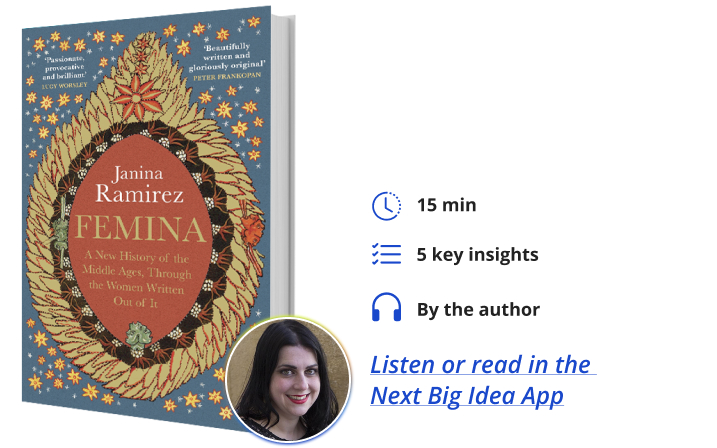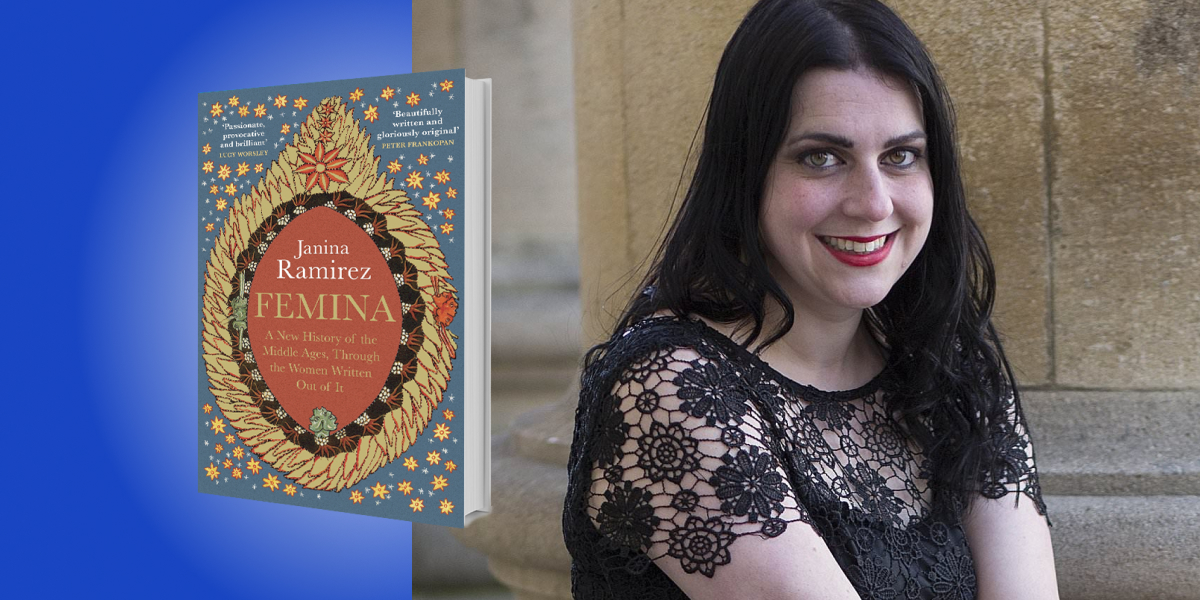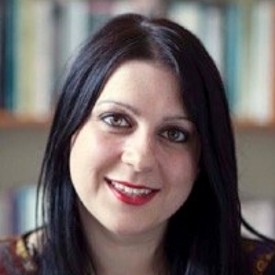Dr. Janina Ramirez is an art and cultural historian, documentary maker and Research Fellow in History of Art at Oxford University.
Below, Janina shares 5 key insights from her new book, Femina: A New History of the Middle Ages, Through the Women Written Out of It. Listen to the audio version—read by Janina herself—in the Next Big Idea App.

1. The suffragettes were not breaking new ground.
The suffragettes, throughout their movement, were trying to return to a medieval time that they considered to be more inclusive. Emily Wilding Davison was a famous suffragette, who died while trying to pin a suffragette banner to the king’s horse during the 1913 derby. She has been remembered as a martyr to the cause and her funeral was the single most-attended non-royal funeral in English history.
What very few people know about Emily, however, was that she was a medievalist who had studied medieval literature at Oxford University. While she wasn’t allowed to graduate, as was the case with all women of the time, she went on to continue writing about medieval themes. She wrote articles and stories about medieval women. When you read Emily’s work, you get a sense that she saw the real potential of women in the medieval period. She saw that they had the ability to have their voices heard and to be empowered both politically, religiously and culturally in a way that she and her 20th-century peers were being denied. Her writings about medieval women venerate and reclaim the power of the women of that time.
The suffragettes were not simply calling for human rights in a vacuum. By earning the right to vote, they were bringing back the agency that they saw that medieval women had during that time.
2. Women have always been warriors and military leaders.
It’s no secret that women can do everything men can do when put under enough pressure. Everyone has heard of stories of mothers lifting cars to save their infants or other seemingly difficult physical tasks. But it’s difficult to find evidence of this from the past.
Looking through ancient texts, there are individuals like Aethelflaed, Lady of the Mercians, who was a consummate leader in Anglo-Saxon England in the 9th century. She led troops against Viking raiders and one of her defenses famously included throwing beehives over the walls of Chester to defend her people.
“Women would defend their castles during sieges, launch counterattacks, and defend their people with every possible means.”
Another example is Cathar ladies, who were revolutionaries under attack during the Crusades in the 13th century. Women would defend their castles during sieges, launch counterattacks, and defend their people with every possible means.
One particular historical figure has redrawn our story of women as warriors. At the beginning of the 20th century, an archeologist named Stolper was excavating a Viking site in Birka, Sweden. He found the remains of a thriving trading town, which was only active for a couple of hundred years. While excavating hundreds of graves at this site, one, in particular, caught his attention. Up on a headland next to the army barracks, was a huge boulder raised on top of a grave. Underneath the boulder, he found an enthroned individual with a complete armory of weapons arranged around them, including two horses at the feet who had been sacrificed and buried with them. On their lap, was a Viking gaming board that was used to plan attacks and defenses.
Stolper announced this to be the finest example of Viking warrior graves to have been discovered. Over the last hundred years though, archeologists have returned to the bones of this warrior and raised questions about them. Finally, in 2019, a team from Stockholm was able to extract the DNA from the bones and teeth and discovered that the individual buried in Birka was a woman. Though we cannot confirm how this person presented herself to society at the time that she lived, the high-status burial site with so many weapons can be telling. Perhaps the board game on her lap suggests that she was a military strategist, who could conduct battles or contribute to the defense of the town of Birka.
3. Women’s rights changed with the Reformation.
We might think that the medieval period was nasty, brutish, and short, a dark age in which all the lights went out and people lived with ignorance and superstition. However, this is simply not the case. This version of the medieval period has been developed and reinforced across the last five centuries, specifically after the reformation. The reformation was a break from Rome, a new age of enlightenment and modernity. Casting everything that came before as dark, ignorant, and superstitious was beneficial to more recent writers and thinkers.
“The medieval convent, though, was somewhat empowering.”
Martin Luther coined the phrase, “A woman’s place is in the home.” With the Reformation, some of the agency that women enjoyed in the medieval period was taken away from them. This is because, in the vast time frame between the 7th and 15th centuries, women had options. Though most women followed the traditional route of being in an arranged marriage with children, they would perhaps help their partners in trade, or take part in other industries as well. They lived in the secular world across different class divides.
There was another route open to them though; they could choose to be put into a religious order. When we think of a convent or nun today we have a fixed view of a pious, restricted person who cuts themself off from the world. The medieval convent, though, was somewhat empowering. In these environments, everything intellectual was taking place. These were the universities, the hospitals, and the creative hubs of the medieval world. In these spaces, women could thrive. They had access to books and education. They were safe from threats from the outside world, away from the risks of death from childbirth. In these environments, they challenged their male contemporaries with their achievements. For example, Hildegard of Bingen became one of the most singular polymaths the world had known in the 12th century.
4. New discoveries are showing us the women hidden in plain sight.
It was DNA analysis that brought us the news that the Birka Viking warrior was a woman. Nowadays, archaeology is telling the story of the many, rather than the few. Every day, there are new archeological discoveries. It is a singularly exciting time to be engaging with history. Archeologists are finding objects, like the handbags of King Jadwiga, who was one of the only female kings in European history. Texts, like The Book of Margery Kemp, are allowing us to tell new stories and bring flesh to real people from the past. Her book tells the story of traveling through the Holy Land up to Sweden down to Spain and across Poland. Her voice is loud, brave, and brazen as she talks about everything, including sex, and what it’s like to be a woman in the beer industry. She was an entrepreneur of her time and thanks to the discovery of her book, we are able to learn about her adventurous life.
These discoveries allow us to tell new stories and bring flesh to what would otherwise be a fragment of evidence that they even existed. These are real, complex, and diverse people who constantly pushed against societal norms to have their voices heard. It’s important to keep an eye on these new discoveries since each one brings us closer and more engaged with the past.
5. The medieval world was incredibly diverse.
We tend to think that people in the medieval world were born, lived, married, and died all within sight of their parish church. The assumption is that there really wasn’t a particularly cosmopolitan world. While it may have been the case for many people living at that time, it is not the full picture.
“London in the 14th century had a racial makeup that was 70 percent white European and 30 percent non-white, including people of African and Asian descent.”
Numerous people were traveling and exploring during the medieval period. During the Viking period, for example, there were individuals who traveled to Constantinople, and even set foot on the Americas, hundreds of years before Columbus. There is also evidence of long-distance trade, namely the Silk Road, which was a vibrant network of travelers and tradespeople. There was evidence of jade being found in Swedish burial sites and silks being woven in Anglo-Saxon England. It was not a world that was disconnected, rather it was a curious one. The Crusades caused new worlds to meet for the first time. Islamic cultures and Christian cultures exchanged scientific, technological, mathematical, and ideological information across their cultural lines.
One recent discovery in 2022 brought to light how diverse the medieval world was. That year, an analysis took place of skeletons found in a burial pit in Spitalfields, London, dated exactly to 1349. Using the newest forensic technology, hundreds of skeletons were able to be identified and classified according to where they were born, where they lived, where they grew up, their health defects, and how they died. These assessments also gave us evidence regarding their genetic backgrounds. What was revealed from this was that London in the 14th century had a racial makeup that was 70 percent white European and 30 percent non-white, including people of African and Asian descent. The current census of London shows that now, 60 percent of people are of white European descent and 40 percent are non-white. That means that walking down the streets of 14th-century London might not have looked so different than walking down those same streets today.
To listen to the audio version read by author Janina Ramirez, download the Next Big Idea App today:






























